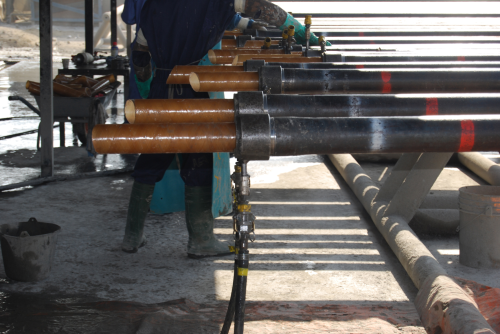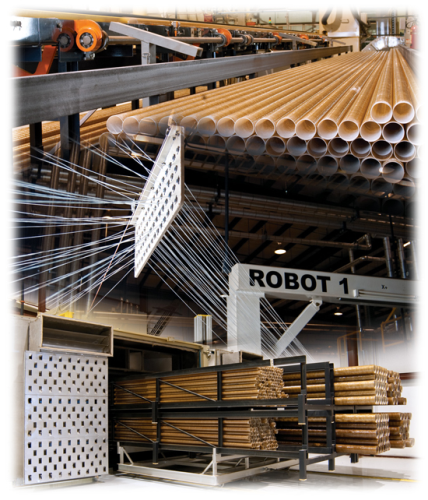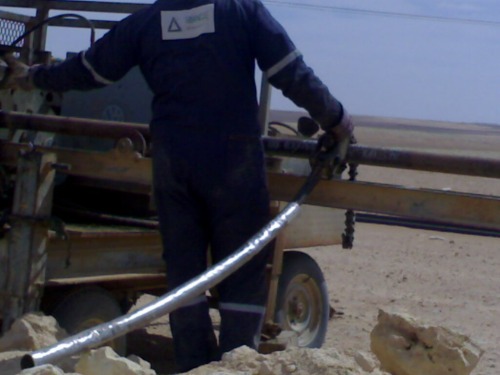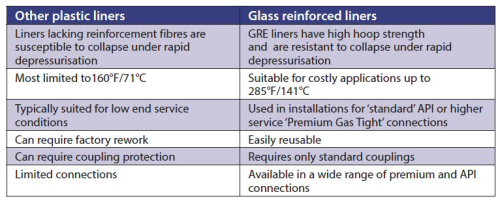




Corrosion in the oilfield can be caused by many sources: hydrogen sulphide (H2S), carbon dioxide (CO2), dissolved oxygen, brinish disposal water, highly acidic soil conditions and many others. Corrosion reduces productivity, and causes downtime for maintenance, or worse, replacement. Each year, corrosion costs oil and gas operating companies billions of dollars in lost revenue and reduced operating profit.
Operating companies involved in oil and gas production have to abide by safe and timely production schedules. In many instances, fluids are so highly corrosive that most tubulars will experience greatly diminished life cycle without some sort of protection. There are ways to minimise the effects of corrosion on the internal surface of oilfield tubulars. The two most commonly used forms of protection are coatings and liners. However, before making any specification for the application, it is necessary to have some basic knowledge of both coatings and liners.
Internal plastic coatings
Originally, most internal coatings were organic solvent-based. However, in the 1970s, pressured by the Clean Air Act, the industry implemented powder coatings to cut use of solvents, hence reducing emissions. Efforts to coat with powder are often unsuccessful because the adhesion of coating to the pipe is often ineffective. One reason for this is that these coatings are thin and unable to resist impact and chip off, which culminates in aggressive localised corrosion. In addition, the coatings are not of universal thickness or found throughout the entire product. Over time these imperfections grow, until there was a complete failure of the piping that would prematurely shut down the system. While many of these powder coatings have improved, it is essential to understand what parameters must exist to ensure success. Table 1 compares internal plastic coatings (IPC) and glass reinforced epoxy (GRE) liners. Before choosing powder coating options, it is recommended qualification tests be conducted. Many coating standards originated from the external coating business. In addition, there tends to be confusion over proper procedures by the extensive number of ANSI, AWWA, API, NACE, DIN and ASTM standards that are associated with coatings and paint. These may not be suitable for internal coatings. Care has to be taken that these standards are not confused with one another and the testing during fit for purpose trials is relevant to the system in question.
Internal tubular polymer liners
In order to properly select a liner, it is essential to assess accurately the entire environment the liner will be exposed to during well servicing and treating operations before making a decision. Without a complete evaluation of the well, environment specifiers could actually reduce the allowable operating temperature and pressure for a liner.
| Overall, glass reinforced epoxy (GRE) liners have solved the problem faced by other tubular corrosion control options. |
Thermoset glass reinforced epoxy (GRE) liners for high temperature and high strength and polyvinyl chloride (PVC) liners for lower temperature applications are the most common options. Recent developments include a family of liners that vary in chemical resistance but share a primary distinguishing feature – the allowable service temperature of each liner material. Overall, glass reinforced epoxy (GRE) liners have solved the problem faced by other tubular corrosion control options. GRE lining systems have a proven track record in a great number of demanding environments including water injection, CO2 injection, gas production, gas-lifted oil production and chemical disposal wells, onshore and offshore. They have an outstanding performance history in harsh environments containing CO2 and H2S. GRE liners have successfully prevented corrosion in gas production wells with high temperatures.
|
Oilfield liners fail primarily as the result of two problems: chemical resistance and encapsulated air pockets. To produce the highly chemical resistant Duoline liner, the manufacturing process begins with a seamless glass reinforced filament. The liner is then wound with fibreglass rovings in a continuous helical pattern to provide the greatest tensile and hoop strength. The glass is then highly saturated during the winding process with a proprietary aromatic resin formulation providing fusion between the fibres, ensuring a holiday-free liner. This full saturation of the fibres provides the necessary chemical resistance for the linings to survive in the field. Encapsulated air pockets are a potential point of failure of a liner over time. Air pockets are often a result of a thermal cure cycle that cures the outer diameter first. This external heating process often entraps air pockets in the liner’s wall. The Duoline manufacturing process differs because it applies internal heat to a hollow mandrel. This internal liner curing process ensures air pockets will not occur on the liner’s wall, ensuring the long-term success in the field for decades. |
One GRE liner that has proven to be successful in the field is fabricated exclusively by Duoline® Technologies. The Duoline liner is manufactured with a filament winding and high temperature cure process. It has 33 years of accumulated field history. Duoline is cured from the inside out, which reduces air pockets and permeability to the greatest degree. The liner can offer an abrasion-resistant coating or lining product in downhole wireline trials in deviated wells. It is acid compatible, resistant to impact, resistant to gas service failures common to other coatings or linings, premium connection compatible, chemically resistant and tolerant to common tension and bending loads.
Case studies
Duoline Technologies GRE liners were installed in an offshore gas injector well in Liverpool Bay, UK, in 1998 with a well depth of 5,700 ft (1737 m). A Duoline 20 product was used with the tube being 7 inches, 29 ppf, L-80. H2S was present at 5% (50,000 ppm) and CO2 present at 2%. The operating temperature was 129°F (53°C). The injection rate was 35 MMscfd. In a Chinese application in the Dagang oilfield in 2001, several wells were lined with Duoline 20 and Duoline30 materials. The well depth was 4000-4500 m and the operating temperature was 329°F (165°C). H2S was present at 0.018% (180 ppm) and there was 9% mol of CO2 present.
Conclusions
In order for oil and gas companies to lower overall tubular capital expenditure costs, reduce tubular maintenance and corrosion prevention, it is necessary to know the best options available. The most effective way to minimise the cost of corrosion on the internal surface of oilfield tubulars starts with a solid knowledge of coatings and liners. One of the key elements in the decision making process will be the environment the tubulars will be operating in. There will be environments where coatings could be the choice for protection, for others liners are the better choice. However, even among liners there are key differences. Glass reinforced epoxy liners have proven to outperform other polymers in protecting tubulars from corrosion and abrasion. ♦
This article was published in the January/February 2014 issue of Reinforced Plastics magazine.
The digital edition of Reinforced Plastics is distributed free of charge to readers who meet our qualifying criteria. You can apply to receive your free copy by completing this short registration form.





